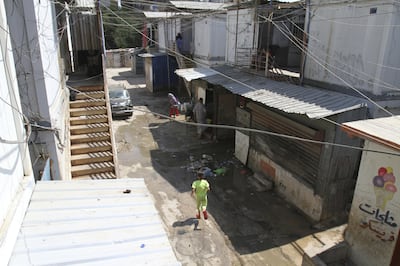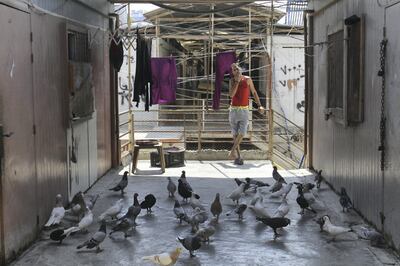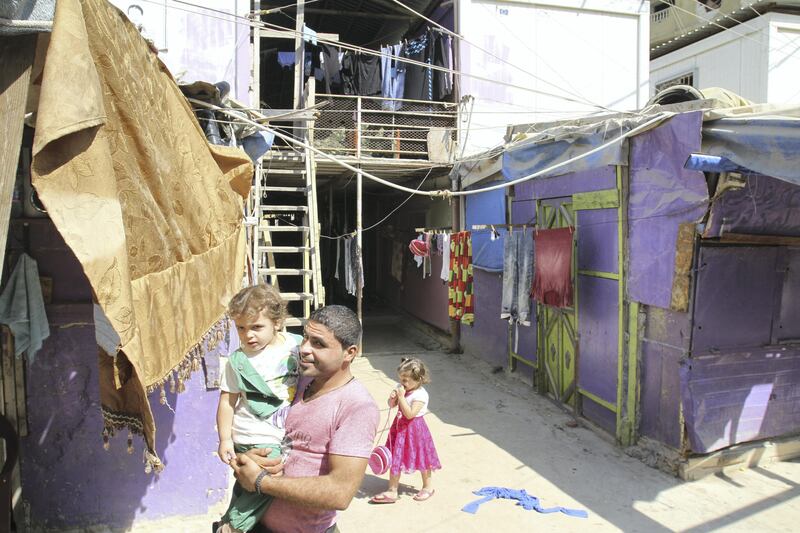Palestinian Nael Abu Siam and his family of eight live in a 29-square metre shipping container in a refugee camp in northern Lebanon. He considers himself one of the lucky ones.
It has been 10 years since fighting between the Lebanese army and a group of militants left the Nahr Al Bared camp in ruins and displaced nearly 30,000 Palestinian refugees.
About half of the camp’s previous population has yet to return, while many of those who have come back live in substandard conditions. Some 300 families live in containers stacked two stories tall.
“We are in a better situation than many people,” said Nael, 50. “We have AC.”
He and others say the uninsulated containers are sweltering in the summer and provide little protection from the cold in winter. The trailers have common walls and are separated by alleyways about two metres wide.
“There’s no privacy,” Nael said. “We can see and hear everything our neighbours do.”
Sanitation is also an issue — sewers often overflow, and garbage lays in piles at the ends of the alleyways.
“We have names for all the rats,” laughed Nael’s mother, who cooks outside on a portable gas burner. “You should hear people scream at night when they see the rats.”
Nael added: “We can hear them running on top of the container.”
Outside their makeshift home, a pile of rat droppings attested to their presence. Rat holes could be seen where the pavement in the alleyways had cracked.
In the decade since the Lebanese army fought the Al-Qaeda inspired Fatah Al Islam militants in the camp, it has received more than $1 billion (Dh3.67bn) in aid from the US alone, according to the US department of state.

Nahr Al Bared is still less than 50 per cent rebuilt. The UN Relief and Works Agency for Palestine Refugees in the Near East (UNRWA), which is responsible for the reconstruction, says a little more than $100 million is needed to finish the job.
When people began to return to the camp in 2008, Nael’s family was among the first. For a year, he said, he had been sharing a room with 11 other people in a school in the Beddawi refugee camp near the city of Tripoli.
UNRWA is responsible for fully rebuilding homes in the part of Nahr Al Bared that is known as “the old camp”. Nael, whose home was in the “new camp”, received money to rebuild his home himself.
“The UN gave me $1,200 to construct my house,” he said. “But I still need about $15,000. So we are still here in Container 64.”
The camp marks the anniversary of the incident on May 20, when the fighting began, rather than on September 2, when it ended. People in the camp say it is because May 20 is close to the observance of Al Nakba — the exodus from Palestine almost 70 years ago. Some refugees refer to the events 10 years ago as the “Nahr Al Bared Nakba”.
Rebuilding of Nahr Al Bared — which like most of Lebanon’s camps is in reality a city made up largely of concrete apartment blocks rather than tents — was initially expected to take three years. The next phase of rebuilding envisions about 700 new units being ready by 2019. That will still leave nearly 2,000 families outside the camp and waiting for housing.
Budget constraints led UNRWA to cut rental subsidies for families still waiting to return about a year and a half ago, leading to demonstrations. A survey on the socioeconomic situation of Palestinians in Lebanon published by the American University of Beirut in 2015 found 72 per cent of Palestinians in northern Lebanon live below the country’s poverty line.
Many of Nahr Al Bared’s residents lost everything in the fighting, which lasted nearly four months.
“We had prepared our house in order to get married,” said Rania Hassan, 33, who was engaged when the fighting started. She and her husband never had the chance to move into their apartment.
“It was destroyed in the fighting,” she said. “We were married two months later in Beddawi camp.”
For the last five years, Rania and her husband have lived in “temporary” housing that is now 10 years old. Their situation is a little better than the families in the containers — their “barracks” are concrete, but they still have many of the same issues. A half-metre board covered the bottom of their doorway to keep rodents out.
“During the winter last year, we lost all our furniture,” she said. “The sewer was blocked and the whole house flooded.”
Rania does not know when she, her husband and two children will be able to move elsewhere. She said their home that was completely destroyed had been built on land that did not belong to the “new camp” or the “old camp”, and that they had received nothing for it by UNRWA.
“[UNRWA] said it was illegal construction,” Rania said.

The protracted nature of the 2007 clashes, during which hundreds of soldiers, militants and civilians were killed, was blamed on the Lebanese army’s antiquated equipment and tactics. It became a reason for foreign militaries to increase their assistance to the Lebanese army.
Last month, in its largest operation since “camp war”, the army received widespread praise for a successful offensive against ISIL fighters in northern Lebanon, ousting hundreds of them from their positions in a battle that took just over a week. Six Lebanese soldiers and reportedly dozens of militants were killed.
“In our imagination, we were going to be gone one week,” said Nawwal Hassan, a local coordinator for Al Najda, an NGO that provides assistance to women and children in the camp. “When we returned, there was nothing. It was flattened.”
“It didn’t just damage the buildings, but the people,” she said. “Is it going to take another 10 years?”
Nawwal also said that the battle had destroyed business in the camp, which used to serve as a market for various goods, including gold, clothing and construction materials.
Army checkpoints at the camp’s six entrances, which were set up following the 2007 clashes, made the situation worse, residents said.
Abu Wissam Salameh, a camp coordinator for the Popular Front for the Liberation of Palestine, said: “It is more difficult for Lebanese people to enter the camp now.”





